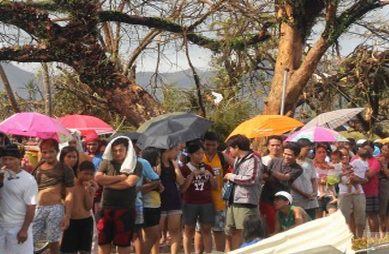There are a number of ways to help people affected by Typhoon Haiyan in the Philippines. You can donate to the Red Cross, UNICEF, the World Food Program and many other worthy charities and NGOs working to save lives and restore dignity to the people affected by this storm.
I’m choosing to donate to the UN’s Central Emergency Response Fund. Here’s why.
International humanitarian disaster response depends entirely on donations and charity. When a disaster like this typhoon occurs, humanitarian first responders need to go to donors hat-in-hand to fund their operations. This process takes time. And in an emergency situation, time is a precious commodity.
This is where CERF comes in. CERF is a standing reserve pool of funds managed by the UN’s Office for the Coordination of Humanitarian Affairs. It is set aside for the quick dispersal of funds so that groups like WFP can purchase food, UNICEF can build latrines, and UNHCR buy tarps and tents on short notice. When a disaster of this magnitude strikes, funds are needed as rapidly as possible and CERF delivers.
On Monday CERF released $25 million to UN agencies to fund Typhoon relief. This was the first big injection of funds and it is being used to pay up front costs of the disaster response as governments and other donors take their time deciding how much they will give. There’s no longer a tedious lag time between a disaster and the humanitarian response thanks to the rapid funding CERF is able to provide.
CERF is relatively new. It was created in 2006 and since then has disbursed $3.3 billion. Beyond rapid response it serves another critical function of disbursing funding several times a year to the most neglected international crisis. This is key because when a disaster is front page news, donors get motivated to help. But when a disaster fades from the headlines, or never makes headlines in the first place, it is much harder to raise funds. The political will to give is simply absent when the crisis is off the radar (think: Chad or Mauritania) of the capitals of traditional donors. The needs are no less urgent.
CERF seeks to remedy this imbalance by periodically distributing funding for the most neglected humanitarian emergencies. So far this year, it has given $74 million to agencies working in places like Madagascar, Somalia, and the DPRK.
The top donors to CERF is the United Kingdom, which has given about $78 million this year. The USA comes it at number 16, with $4 million. In total, CERF has collected $444 million this year, and given out $435 million for 34 rapid response emergencies and 22 neglected crises.
Needless to say, these reserves need to be built back up. The world needs a funding pool like CERF to quickly disperse dollars when tragedy strikes and steer funding toward slow burning crises that do not get the attention they deserve.
I’ve just texted CERF to 90999 to make a contribution. Here are other ways to donate.
